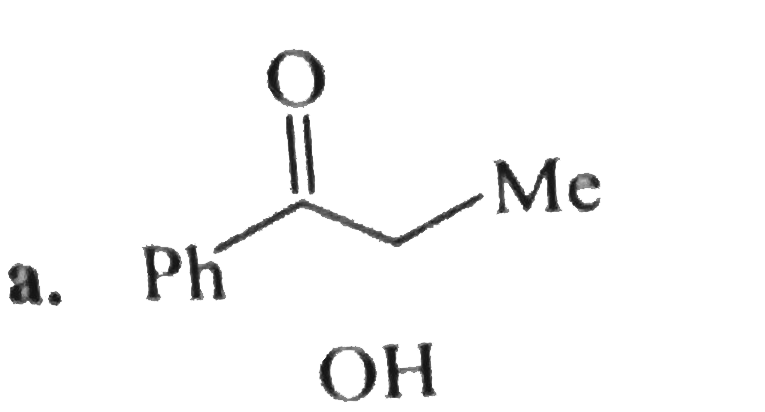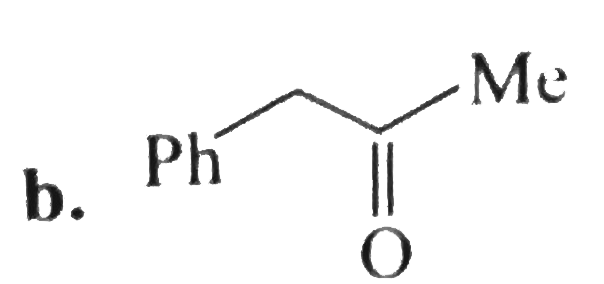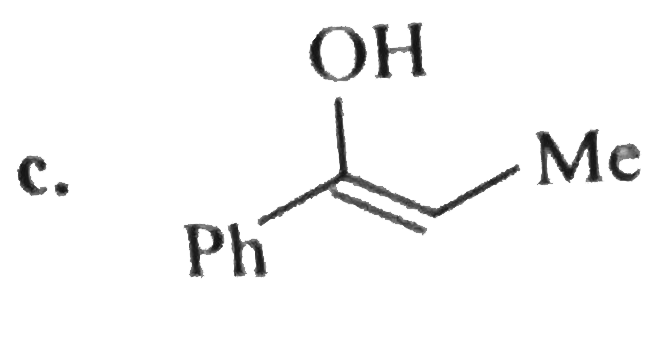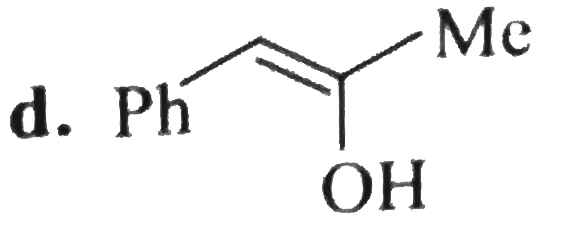PhC≡CMeHg2++H⊕−−−−−−−→(A).<br>Thecompound(A) is:
a.
b.
c.
d.
The correct Answer is:A
To solve the given question, we need to analyze the reaction of the unsymmetrical alkyne with mercuric ion (Hg²⁺) in the presence of an acidic medium. The alkyne in question is PhC≡CMe (phenylacetylene). Here’s a step-by-step breakdown of the reaction:
Step 1: Formation of the Mercuric Ion Complex
The first step involves the attack of the mercuric ion (Hg²⁺) on the triple bond of the alkyne. This results in the formation of a mercuric alkyne complex. The triple bond between the carbon atoms (C≡C) converts to a double bond (C=C) as the mercuric ion forms a bond with one of the carbon atoms.
Hint: Remember that the mercuric ion acts as an electrophile and will preferentially bond to the carbon that can stabilize the resulting positive charge.
Step 2: Hydrolysis of the Complex
Next, we perform hydrolysis of the mercuric complex. Water (H₂O) acts as a nucleophile and attacks the carbon atom that is bonded to the mercuric ion. Due to resonance stabilization from the phenyl group (Ph), the oxygen in water donates its lone pair to the carbon atom that is more stabilized by the adjacent phenyl group.
Hint: Consider the stability of the carbocation formed during this step; resonance stabilization plays a crucial role.
Step 3: Formation of the Intermediate
After hydrolysis, we will have an intermediate compound where one carbon has an -OH group (from water) and the other carbon is still bonded to the mercuric ion. The structure at this point is a vinyl alcohol (enol) form.
Hint: Focus on the structure of the intermediate; it will have an -OH group and a double bond.
Step 4: Protonation and Rearrangement
In the next step, we add an acid (H⁺) which will protonate the -OH group, making it a better leaving group. The mercuric ion (Hg) will be replaced by a hydrogen atom, leading to the formation of a double bond between the two carbon atoms.
Hint: Understand that this step involves the loss of the mercuric ion and the formation of a more stable alkene.
Step 5: Tautomerization to Form the Final Product
Finally, the compound undergoes tautomerization, where the hydrogen atom shifts to the adjacent carbon atom, resulting in the formation of a ketone. The final product (compound A) is thus a ketone with a phenyl group and an ethyl group.
Hint: Tautomerization is key in converting the enol form to the more stable ketone form.
Conclusion
The final compound A is a ketone with the structure PhC(=O)CMe, which corresponds to the option given in the question.
Final Answer: The compound (A) is a ketone, specifically phenylacetone.
The first step involves the attack of the mercuric ion (Hg²⁺) on the triple bond of the alkyne. This results in the formation of a mercuric alkyne complex. The triple bond between the carbon atoms (C≡C) converts to a double bond (C=C) as the mercuric ion forms a bond with one of the carbon atoms.
Next, we perform hydrolysis of the mercuric complex. Water (H₂O) acts as a nucleophile and attacks the carbon atom that is bonded to the mercuric ion. Due to resonance stabilization from the phenyl group (Ph), the oxygen in water donates its lone pair to the carbon atom that is more stabilized by the adjacent phenyl group.
After hydrolysis, we will have an intermediate compound where one carbon has an -OH group (from water) and the other carbon is still bonded to the mercuric ion. The structure at this point is a vinyl alcohol (enol) form.
In the next step, we add an acid (H⁺) which will protonate the -OH group, making it a better leaving group. The mercuric ion (Hg) will be replaced by a hydrogen atom, leading to the formation of a double bond between the two carbon atoms.
Finally, the compound undergoes tautomerization, where the hydrogen atom shifts to the adjacent carbon atom, resulting in the formation of a ketone. The final product (compound A) is thus a ketone with a phenyl group and an ethyl group.
The final compound A is a ketone with the structure PhC(=O)CMe, which corresponds to the option given in the question.
Topper's Solved these Questions
- REDUCTION AND OXIDATION REACTION OF ORGANIC COMPOUNDSBOOK - CENGAGE CHEMISTRY ENGLISHCHAPTER - REDUCTION AND OXIDATION REACTION OF ORGANIC COMPOUNDSEXERCISE - SUBJECTIVE TYPE
4 Videos
- REDUCTION AND OXIDATION REACTION OF ORGANIC COMPOUNDSBOOK - CENGAGE CHEMISTRY ENGLISHCHAPTER - REDUCTION AND OXIDATION REACTION OF ORGANIC COMPOUNDSEXERCISE - Exercise (Assertion And Reasoning)
10 Videos
- QUALITATIVE INORGANIC SALT ANALYSISBOOK - CENGAGE CHEMISTRY ENGLISHCHAPTER - QUALITATIVE INORGANIC SALT ANALYSISEXERCISE - Viva Voce Questions And Part-C (Analysis Of Cations)
42 Videos
- SOLID STATEBOOK - CENGAGE CHEMISTRY ENGLISHCHAPTER - SOLID STATEEXERCISE - Ex 1.2 (Objective)
9 Videos
Similar Questions
Knowledge Check
Identify the compound C in the following sequence:
(CH3)2CHCH2C≡NHCl,H2O−−−−−→compound A1.LiAlH4−−−−−→2.H2Ocompound BPC−−−−→CH2Cl2Compound CA(CH3)2CHO∣∣CCH3B(CH3)2CHCH2O∣∣COHC(CH3)2CHCH2O∣∣CHD(CH3)2CHO∣∣CCH2OHAn organic compound (A), C7H6O gives positive test with Tollen's reagent, on treatment with alcoholic CϴN,(A) yields the compound (B),C14H12O2. Compound (B) on reduction with Zn-Hg, HCl and dehydration gives an unsaturated compound (C), which adds on mole of Br2/CCl4. The compound (B) can oxidized with HNO3 to a compound (D), C14H10O2. Compound (D) on heating with KOH undergoes rearrangement adn subsequent acidification of rearranged products yields an acidic compound (E), C14H12O3.
Compound (A) cannot undergoABenzoin condensationBCannizzaro reactionCAldol condensationDPerkinAn organic compound (A), C7H6O gives positive test with Tollen's reagent, on treatment with alcoholic CϴN,(A) yields the compound (B),C14H12O2. Compound (B) on reduction with Zn-Hg, HCl and dehydration gives an unsaturated compound (C), which adds on mole of Br2/CCl4. The compound (B) can oxidized with HNO3 to a compound (D), C14H10O2. Compound (D) on heating with KOH undergoes rearrangement adn subsequent acidification of rearranged products yields an acidic compound (E), C14H12O3.
Structure of compound (B) isA B
B C
C D
D
On heating ZnCl2.2H2O, the compounds obtained is:
View SolutionIn the reaction
H−C=C−HNaNH2−−−−→ACH3I−−→BHg2+−−−→H3O+C
the final product 'C' is :
View SolutionOn heating ZnCl2.2H2O, the compounds obtained is
View SolutionA compound 'X' (C2H4O) on oxidation gives 'Y' (C2H4O2). The compound 'X' undergoes haloform reaction. Write the structure of 'X' and 'Y'.
View SolutionNa2B4O7Δ−−→NaBO2+B2O3
NaBO2+H2O2+H2O→ compound A(aq)
The compound A the sum of oxidation states of all the oxygen atoms is X. Then the value of (X) is
View Solution
